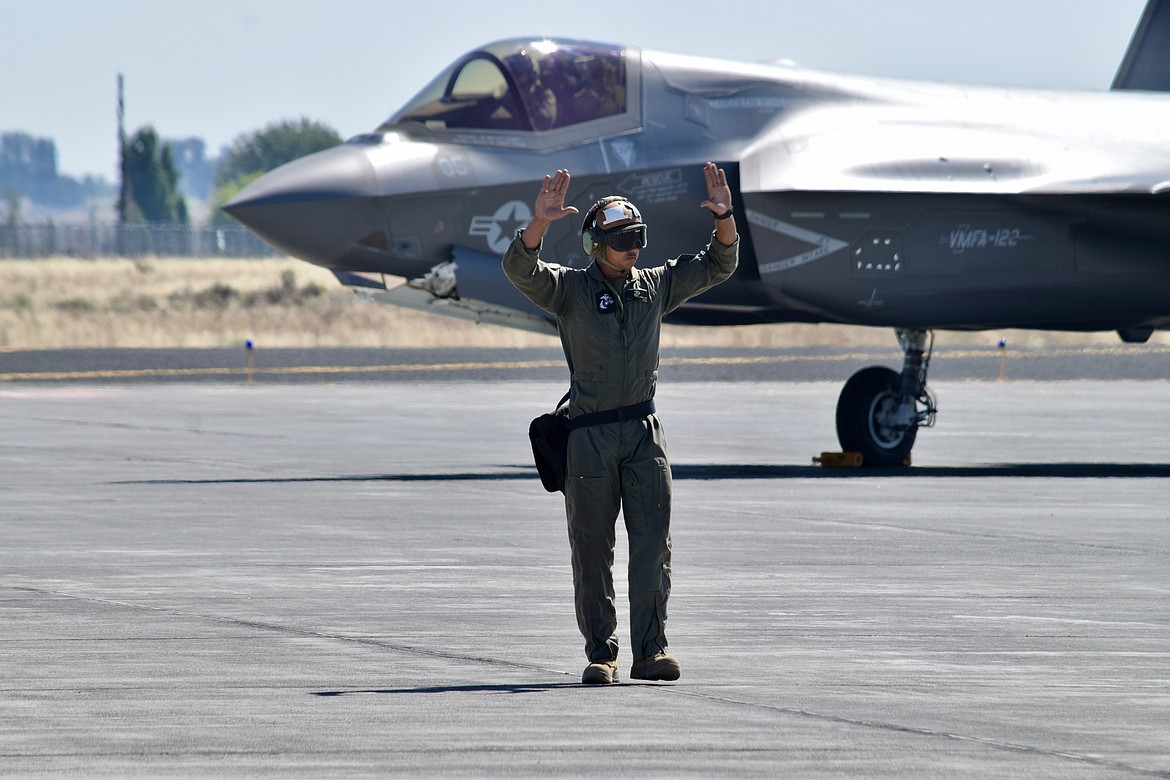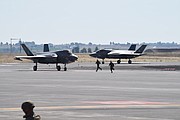Summer Fury: Marines deploy to Moses Lake for training exercise
MOSES LAKE — The north end of the Grant County International Airport’s main runway is not the best camping spot in the world.
But for a group of Marines from Camp Pendleton, California, it was just another place to put up their tents and bivouac this week.
“We slept out here, and it gets really hot at oh-six,” said Chief Warrant Officer 2 Micah Martinez, referring to 6 a.m. “It was nice going to sleep, a nice 60 degrees. But it warms up really fast out here.”
“And it’s a little lumpy,” Martinez added.
Not that the Marines of the 3rd Marine Aircraft Wing had much time to worry about how comfortable the Columbia Basin scrubland was, Martinez said. After arriving around 5 p.m. Wednesday, they spent the next seven hours putting up tents and getting 30,000 gallons of jet fuel ready to create a forward arming and refueling point (FARP) at the GCIA, part of the Summer Fury 21 exercise to test the U.S. Marine Corps’ ability to deploy quickly, set up a small base, and conduct military operations against potential enemy ships roughly 1,000 miles away.
“This basically expands our reach,” said 1st Lt. Nick Paglialonga, a media engagements officer with the USMC. “We can go land in austere places and have this whole capability, not only to land aircraft, but to refuel, put ordnance on and switch pilots out if need be.”
“It helps us push the fight a little bit closer to the enemy,” he added.
The exercise involved four F-35 Lightning II fighters and two F/A-18 Hornets from southern California flying up here, taking on fuel, and flying more than 950 miles south to the San Nicholas and San Clemente islands to conduct a series of live-fire strikes against potential enemy warships.
The planes then came back, refueled, rearmed, took on new pilots, and flew back to southern California for a second round of strikes.
In addition, a Marine infantry unit deployed to the GCIA and took off in several MV-22 Ospreys for a mock attack on an undisclosed location, and ground crews refueled a C-130 Hercules aerial refueling plane.
It’s an important training exercise for pilots and ground crews, said Martinez, who as a bulk fuel officer is in charge of making sure the planes are quickly and properly refueled as they sit in “hot pits” with their engines running as crews look them over.
“It went really smooth, though the first shift is always the roughest,” Martinez said after the first practice strike wave was off. “All the problems that came up were very minor, and the next one will be way smoother.”
Paglialonga said this kind of deployment is something the Marines of the 3rd Marine Aircraft Wing have practiced a lot recently.
“This is the third or fourth time I’ve covered something like this,” he said.
However, Paglialonga said it was also fairly unique for the USMC to deploy to a civilian airport for this kind of operation, but using the GCIA as a forward base makes a lot of sense given the Corps’ mission.
“It kind of ties into our expeditionary nature,” he said.
Airport Director Rich Mueller said while the Port of Moses Lake has hosted Army and Air Force exercises before, this is the first time for a large-scale Marine operation.
“It’s the first chance we’ve had to really kind of provide all the airfield to the Marines,” Mueller said. “And they’ve been great.”
Even as the Marines of the 3rd Marine Aircraft Wing were busy fueling and checking their jets, the airport was still very much business as usual, with Boeing passenger jets, Navy patrol planes, Air Force transports, and Big Bend Community College flight school students all taking off and landing.
It’s one of the advantages of the GCIA’s five runways, Mueller said.
“The fact that we can do all of those things at the same time, plus have the Marine Corps exercise that has so many components, really shows just how far-sighted the founders of the Port of Moses Lake were when they decided to take on this airport,” he said.
Mueller hoped the Marines, who leave Moses Lake Friday, will use the airport for more training exercises.
“Sooner rather than later,” he added.
Charles H. Featherstone can be reached at cfeatherstone@columbiabasinherald.com.









